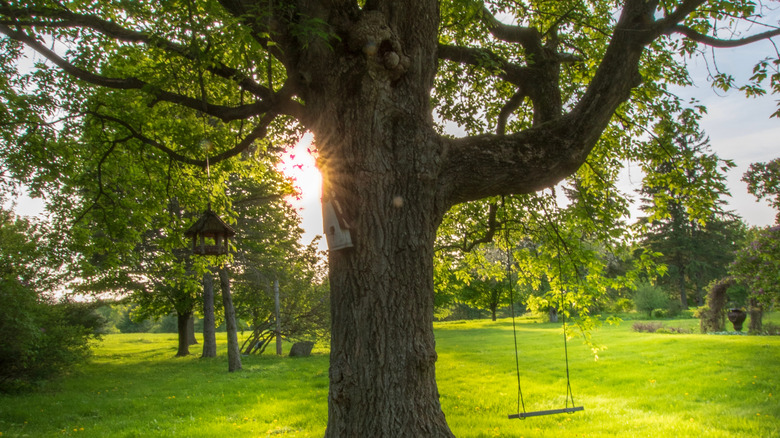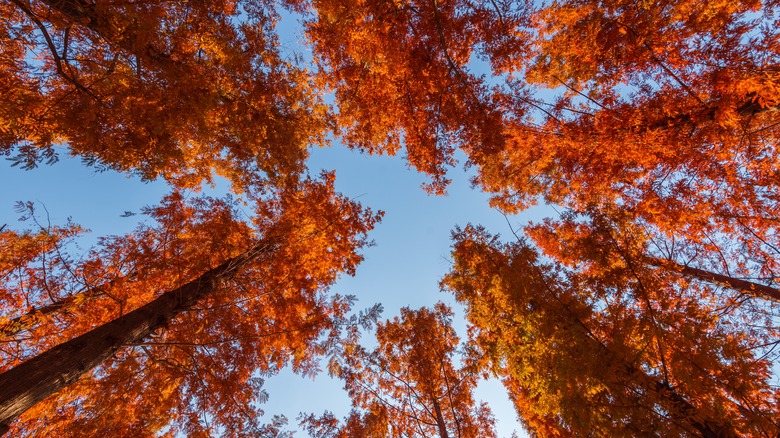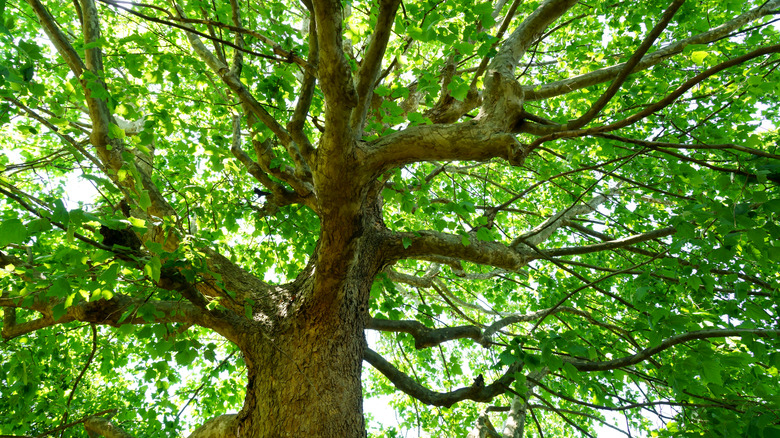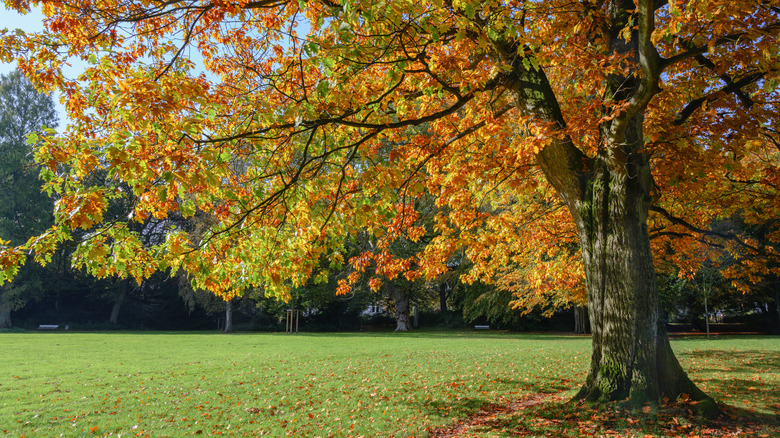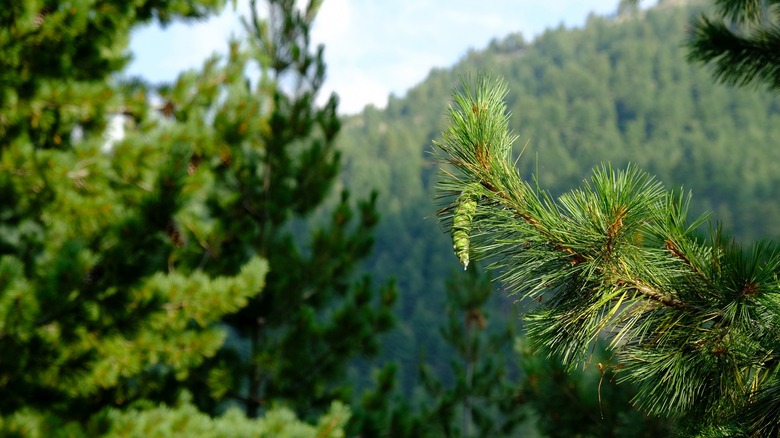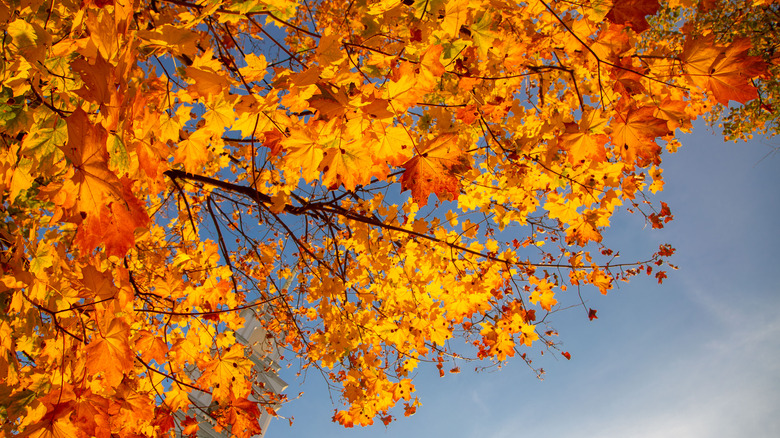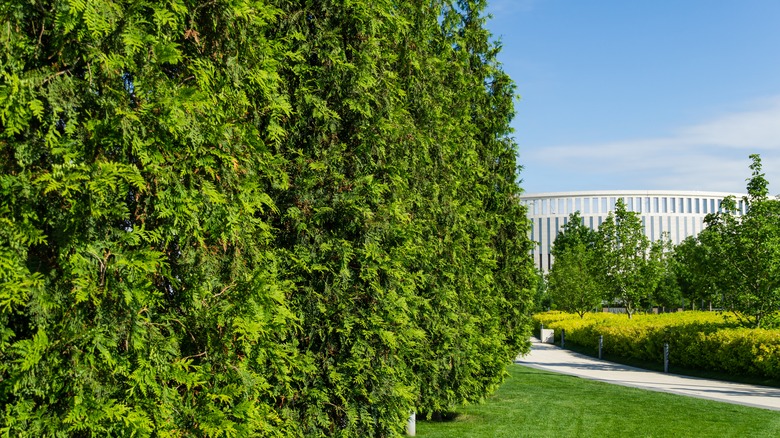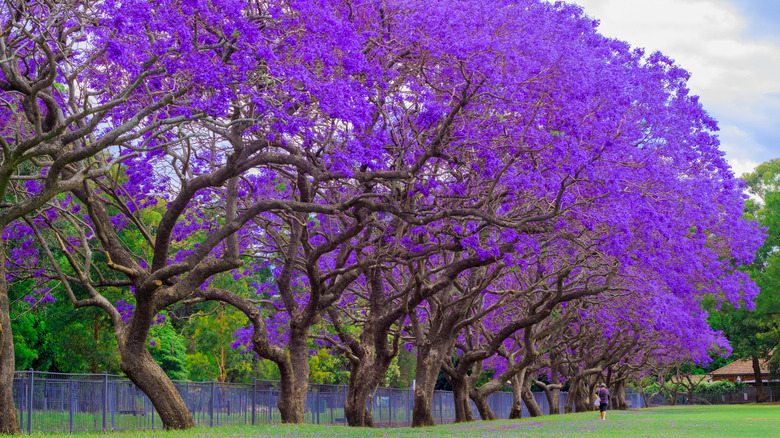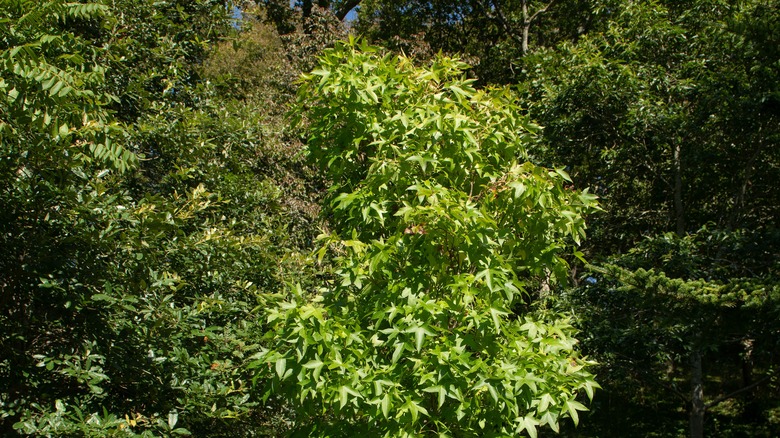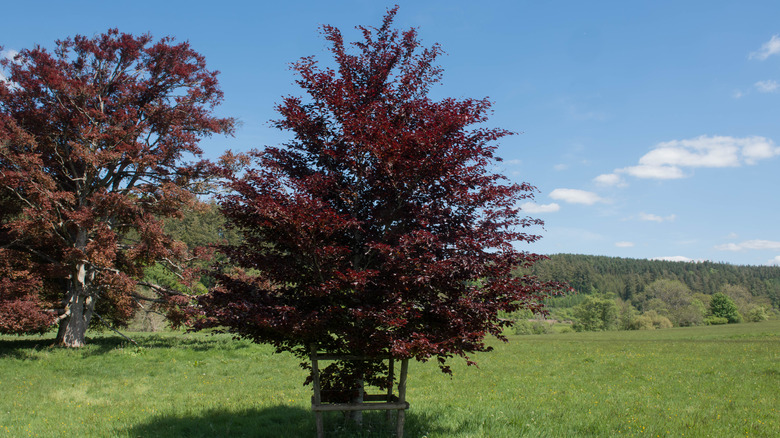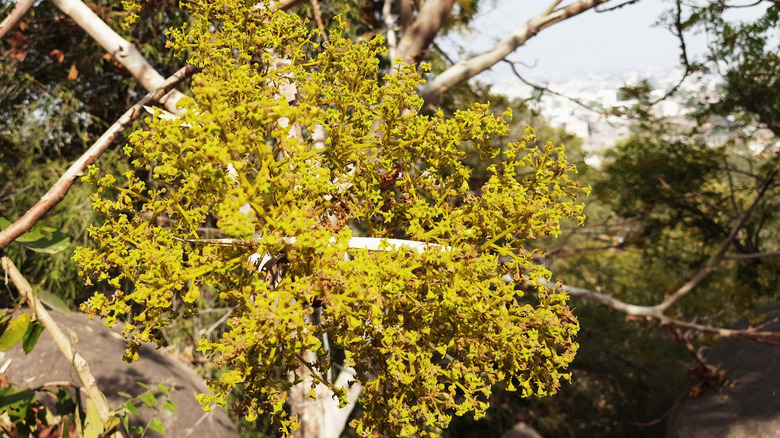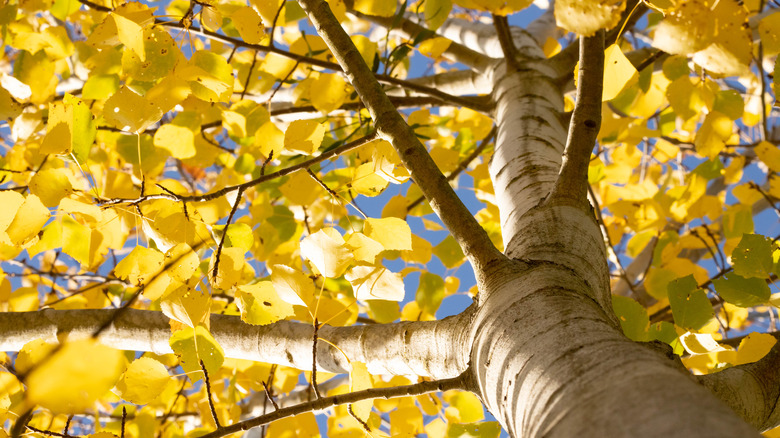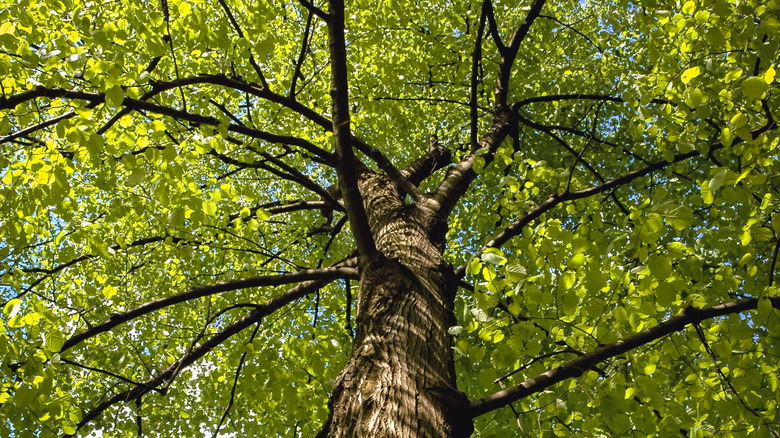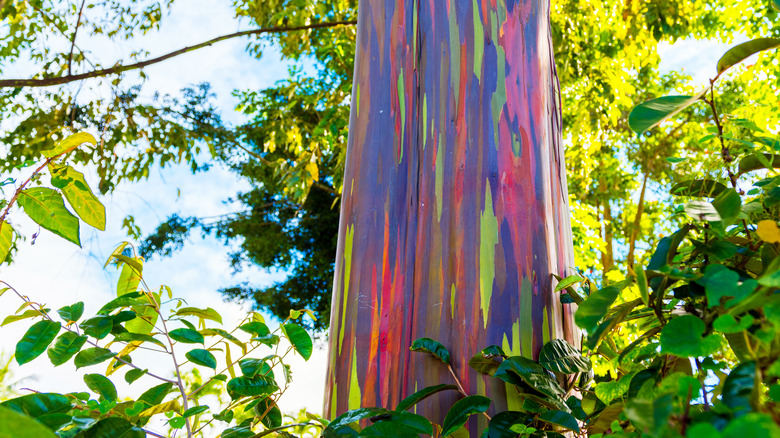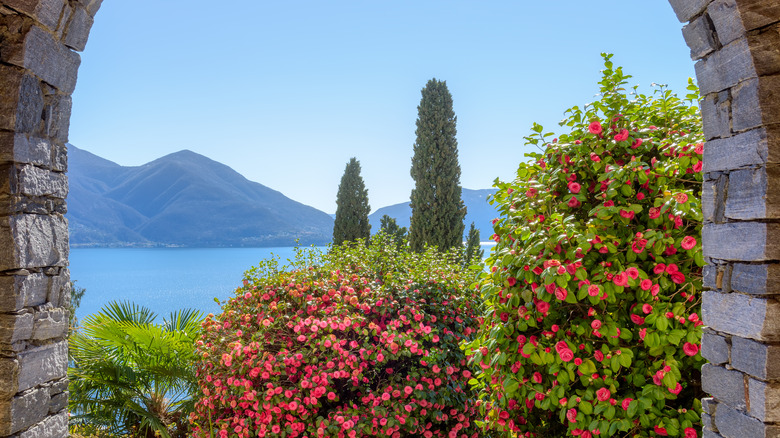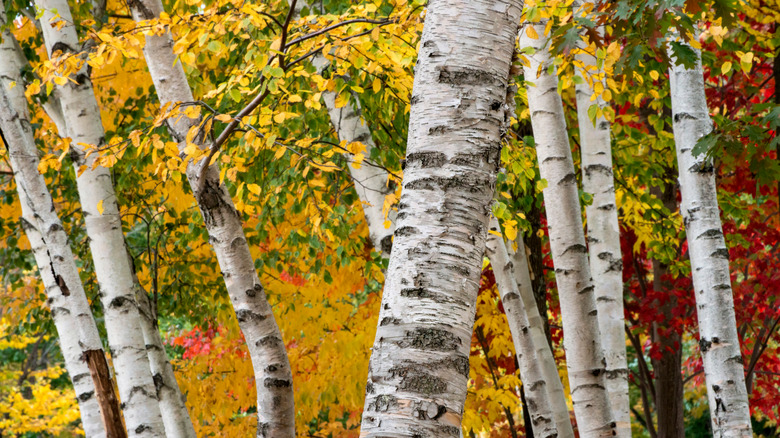15 Trees You Can Plant That Will Grow Super Tall
An ancient Chinese proverb advises that the best time to plant a tree is 20 years ago; the second best is now. And the taller the tree, the greater the eventual benefit. Taller trees provide wind breaks around your home, they attract wildlife to your personal ecosystem, and they offer additional privacy for you and your family. Of course, we're not talking about giant sequoias here, but trees that are proportionate to the size of your home.
As a word of caution, you should exercise care in how close to your house you plant a tree, according to Complete Landscaping. Planting too close puts you at risk for damage to the roof, windows, and sides of your home from branches that come loose in a windstorm or through decay. Tree roots can cause serious harm to the underground pipes that provide water and sewer drainage for your home. They can also cause water to collect, which increases the chances of rotting your house below ground. In some cases, roots can actually crack or rupture the very foundation of your structure. Repairing any of these can be painfully expensive — and that's if you find them in time.
Having a plan for where to plant will only work in your favor. That said, here are 15 trees that can definitely enhance the beauty and curb appeal of your home, create shade in a hot sunny backyard, give you colorful foliage in the fall, and provide decades of happy coexistence with nature.
1. Dawn redwood
The dawn redwood (Metasequoia glyptostroboides) provided shade for the dinosaurs 50 million years ago. Back then, this tree was commonplace throughout Western Europe, Greenland, and the Americas. By the 20th century, it had all but vanished, to be seen only in fossils until it was rediscovered in China during the 1940s, per Save the Redwoods.
As the smallest of the redwoods, this deciduous and cold-resistant conifer reaches heights of 60 feet. It likes temperature zones four through eight, and since you can see these trees even from a distance, they make an impressive addition to any large landscape.
2. American sycamore
American sycamore (Platanus occidentalis) trees are built for shade and climbing. Their exfoliating bark resembles camouflage, say the experts at Native Plant Trust. The sycamore is often found in places where moisture is close to the surface, near ponds and streams. It's also known as the buttonwood tree.
Plant one of these deciduous trees (in zones four through nine), and you'll eventually have one that approaches 100 feet tall. They're indigenous to the Eastern U.S., and are renowned for having the largest trunk of any native hardwood. Hammocks are not included.
3. Northern red oak
The northern red oak (Quercus rubra) is a fast grower that can reach 20 feet or more in just 10 years. When well-tended, they've been known to eventually reach heights from 60 to 75 feet. These trees give off serious Norman Rockwell vibes and you can expect spectacular red hued leaves when fall arrives, says the Arbor Day Foundation.
This tree is deciduous (shedding its leaves annually), thrives in zones three through eight, and can tolerate compacted soil that is drier than it is wet and salty climes. Its acorns are popular with a variety of wildlife.
4. Eastern white pine
The eastern white pine (Pinus strobus) asserts itself quickly. From ages 15 to 45, these trees can shoot skyward three or four feet per year. At their tallest, you can expect the next generation of your family to see them reach heights of 150 feet, according to Adirondacks Forever Wild.
In fact, the eastern white pine is the largest conifer native to the American east, and its lifespan can be 400 years. This pine's pyramid shape makes it ideal as a windbreaker and fun for yuletide decorations. Yes, there will be needles. But also... pine cones!!
5. Red maple
The red maple (Acer rubrum) can help you with your plans to live large — because they can reach heights of 20 feet in their first decade. Most often, they'll stay in the range of 60 to 90 feet, and birds love them.
Red maples are among the most common trees found in the Central and Eastern areas of the U.S. and Canada, in zones eight and nine. Educators at Lady Bird Johnson Wildflower Center say they're best used as shade trees for picnic tables and enormous piles of beautiful leaves to romp through when autumn arrives.
6. Thuja
Thuja Green Giant (Thuja standishii x plicata 'Green Giant') is ideal for creating privacy and wind breaks. It's a dense, vertically slender tree that's a hybrid of two different plants from separate continents joined to create a third, say the authorities at the American Conifer Society.
They're tolerant of many soil types and resistant to both snow and ice; though they do best in zones five through eight. Within 15 years of planting, you should have a tree between 20 and 30 feet tall that can live for a few hundred years.
7. Jacaranda
Eye-catching jacaranda trees (Jacaranda mimosifolia) will give you a pop of color that's as psychedelic as nature gets. Jacarandas grow to be in the range of 25 to 50 feet tall, which is a manageable size that won't dwarf a typical suburban home. Their purple spring blooms yield to yellow in the fall. In other words: These trees make a statement.
Jacarandas have the ability to thrive in an assortment of soil types, according to Fast Growing Trees. They need very little water once established, and they will make themselves at home in zones nine through 11.
8. American sweetgum
The American Slender Silhouette sweetgum (Liquidambar styraciflua 'Slender Silhouette') is a veritable skyscraper. Plant them like sardines, since they're generally no more than six feet wide yet they'll tower at 60 feet tall. Not only that, but they'll also put on a show every fall, say the writers at Horticulture Magazine, as their verdant summer leaves turn an unending variety of hues from yellow to orange and red to purple.
This drought-resistant deciduous tree likes full sunlight and thrives in zones five through nine. It also works well on coastal shores with salty air and moist soil.
9. Beech
The Red Obelisk beech tree (Fagus sylvatica 'Red Obelisk') reaches heights of 40 feet and adds an aura of grandeur and curb appeal to a front yard. Being low-maintenance doesn't hurt, either. This tree requires regular watering only until it's settled into its home, and it rarely needs pruning.
Unlike many on the list here, this deciduous tree is a slow grower. Best fit for zones five through nine, according to the Chicago Botanic Garden, its cylindrical shape gives it an almost columnar look. How about a trimmed set on either side of your front door? Impressive.
10. Chinese pistache
Chinese pistache (Pistacia chinensis) is the name of this low-maintenance tree that, at 40 feet, won't overshadow a single-story dwelling. It's rather hardy, produces an array of colors as the summer wanes into fall, and is both wind- and drought-resistant say the educators at North Carolina State's Extension Gardener.
These umbrella-like trees need full sun and provide abundant shade in return. They are enormously popular in their natural habitats — zones six through 10 — which can be found all over the nation. Chinese pistache trees work well in a variety of soil types; just don't overwater them.
11. Quaking aspen
The quaking aspen (Populus tremuloides) is a tree for childhood dreams; climbing up or sitting beneath, listening to the signature quake of its leaves in the wind. Think of it as the Labrador of trees, because you'll eventually consider it part of the family.
Aspens shoot up fast, just like kids, although at a rate of five feet per year. Quaking aspens thrive in zones two through seven, per Washington State's Clark County Extension, and they aren't fussy about soil or cold temperatures. This is a keeper that will soar up to 50 feet when fully mature.
12. American linden
The American linden tree (Tilia americana) is known alternately as the basswood tree. It has delighted generations with its deeply verdant leaves that supply untold hours of shade, and flowers that attract bees to create the delicacy known as basswood honey. Linden trees reach heights of 80 feet, according to the U.S. Forest Service.
This deciduous tree is renowned for its sturdy wood, gorgeous green and white blossoms, and the shade provided by its dense foliage. It thrives in zones three through eight, and can be found across the continental U.S.
13. Rainbow eucalyptus
As the Rainbow eucalyptus tree (Eucalyptus deglupta) grows, it sheds its bark to reveal a wild assortment of colors beneath the surface, explains the experts at One Earth. When you have a tree that grows to heights of 80 feet tall that looks like it's been painted by an elementary school art class, you know you've got a delight to the eyes that will attract attention for years to come.
These trees will grow up to three feet per year, and they like it hot. As such, they're best suited to zones nine through 11.
14. Italian cypress
The Italian cypress (Cupressus sempervirens) maintains the same stately elegance that the ancient Romans appreciated centuries ago. These quick growers stand as silent sentinels, telegraphing an aura of sophistication and distinction. They're narrow, growing up to three feet per year and topping out at around 60 feet.
Cypress trees do best in zones eight to ten, so they're common sights in states like California. According to Meadows Farms, they'll adapt to most soil types. They're resistant to frost and even smog. Cypress trees are dense and evergreen, which makes them perfectly suited to mark property lines.
15. Paper birch
A paper birch tree (Betula papyrifera) provides all the drama you could wish for in a tree that will eventually tower over your landscape. There's such a powerful connection to Americana with this particular birch that it's named New Hampshire's state tree. The contrast between its white trunk and branches and leaves that turn from green to gold make it a natural work of art.
This tree will grow upwards of 70 feet tall, say the arborists at the Arbor Day Foundation. It's moderately drought-tolerant, and grows best in zones two through seven.
